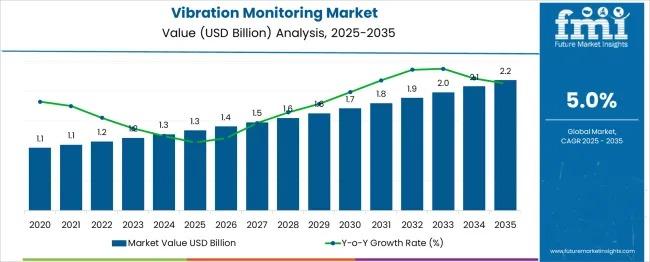Vibration Monitoring Market to Surpass USD 2.2 billion by 2035

The Vibration Monitoring Market is poised for sustained expansion between 2025 and 2035 as U.S. industries accelerate their transition toward predictive maintenance and smart operations. The market is valued at USD 1.3 billion in 2025 and is projected to reach USD 2.2 billion by 2035, advancing at a 5.0% CAGR over the forecast period. This growth reflects rising demand for real-time equipment diagnostics, improved operational reliability, and integrated monitoring systems across energy, manufacturing, oil and gas, and transportation sectors.
Subscribe for Year-Round Insights → Stay ahead with quarterly and annual data updates:
https://www.futuremarketinsights.com/reports/sample/rep-gb-23018
The period between 2025 and 2030 is expected to see the market rise from USD 1.3 billion to USD 1.7 billion, driven by increasing deployment of condition-based monitoring systems. IoT-enabled sensors, cloud analytics, and AI-assisted fault detection are becoming essential to asset performance management strategies. By 2028, the market will reach USD 1.6 billion, reflecting the rapid digital transformation of industrial environments. These technologies are enabling companies to reduce downtime, extend equipment life cycles, and improve productivity through data-driven maintenance.
Vibration Monitoring: A Cornerstone of Predictive Maintenance
Vibration monitoring holds a prominent 28–30% share within the broader condition monitoring ecosystem, reinforcing its critical role in early fault detection for rotating equipment. It contributes 20–22% within the predictive maintenance solutions market, highlighting its importance in operational efficiency. With Industry 4.0 initiatives reshaping manufacturing and energy systems, the market is expanding rapidly as industries integrate advanced analytics and automation platforms.
In rotating equipment applications—turbines, motors, pumps, compressors—the market accounts for 35–38% share, the highest among related sectors. The need for continuous monitoring and failure prevention directly drives adoption in the U.S. and globally.
Segmental Insights: Hardware, Online Monitoring, and Embedded Systems Lead
Hardware leads the market with a 48.3% share in 2025, supported by demand for high-performance sensors, transmitters, and data acquisition units. These components form the backbone of industrial vibration monitoring, offering precise, durable, and consistent measurement capabilities necessary for critical infrastructure.
Online monitoring systems dominate with a 56.7% share in 2025, as industries prioritize real-time fault detection without interrupting operations. Their seamless integration with centralized control systems strengthens decision-making and maintenance scheduling efficiencies.
Embedded vibration monitoring systems are set to capture 42.1% share in 2025 due to their ability to process data at the equipment level. These systems reduce latency, support autonomous diagnostics, and enhance reliability — a key advantage for the U.S. manufacturing, energy, and aerospace sectors.
Growth Drivers: Why the Market Is Accelerating
Several long-term drivers strengthen the U.S. market outlook:
- Predictive Maintenance Becomes Standardized
Companies are increasingly shifting from reactive to proactive maintenance. Vibration monitoring solutions are essential for detecting bearing faults, structural imbalances, and motor misalignment well before critical failure. - Wireless Sensors Expand Deployment Potential
Wireless technology is enabling broader adoption across geographically dispersed assets, including wind farms, pipelines, and remote industrial operations. Lower installation cost, scalability, and long battery life enhance market acceptance. - Industry 4.0 and IIoT Integration
Smart factories across the U.S. are embedding vibration sensors and analytics within automated systems. AI-driven monitoring and digital twin technology are accelerating the digital transformation of industrial maintenance.
Barriers: Cost Constraints for Smaller Facilities
Despite strong growth, high upfront investment in advanced monitoring systems remains a challenge for small and mid-sized plants. Costs associated with hardware, software platforms, and skilled installation personnel affect adoption rates in cost-sensitive industries. Subscription-based models and low-cost wireless systems are expected to help bridge this gap in the coming years.
Competitive Landscape
The U.S. vibration monitoring market is moderately consolidated, with Emerson Electric, General Electric, Honeywell International, AB SKF, Rockwell Automation, National Instruments, Meggitt, and Analog Devices leading the competitive landscape. These players focus on developing wireless monitoring networks, AI-enabled diagnostics, and cloud-integrated platforms tailored for complex industrial applications.
As North America maintains its position as an innovation hub for industrial automation, the U.S. is expected to remain a high-value market for next-generation vibration monitoring technologies through 2035.
- Art
- Causes
- Crafts
- Dance
- Drinks
- Film
- Fitness
- Food
- Giochi
- Gardening
- Health
- Home
- Literature
- Musica
- Networking
- Altre informazioni
- Party
- Religion
- Shopping
- Sports
- Theater
- Wellness


